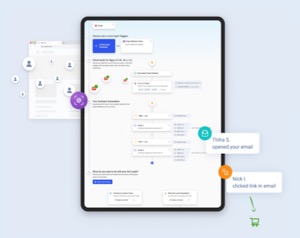On February 22, the Ad Universe Summit took the digital marketing world by storm, packing a punch with its 5-hour marathon of cutting-edge advertising wisdom.
Bringing together 22 top-notch advertising experts, we dove deep into everything from crafting killer ad creatives to mastering Facebook and Google ads, not to mention YouTube and LinkedIn strategies.
It wasn’t just about the big names, though. With over 2000 registrants, the summit truly was buzzing with enthusiastic marketers eager to level up their game.
Now, we could go on for days and days about the sessions and the information provided, but we don’t have that kind of time and neither do you.
Instead, let’s look at 21 key takeaways from the summit that you can add to your marketing strategies right now.
Convert Website Visitors into Real Contacts!
Identify who is visiting your site with name, email and more. Get 500 contacts for free!
1. Don’t Rent. Own Your Ad Pixel – Larry Kim

CEO, Customers.ai
Until not too long ago, the standard approach was to rely on ad platforms for pixel tracking. You’d grab their pixel, slot it into your site, and let it feed data back to their servers.
But this method has its drawbacks: match rates often disappoint, data enrichment is non-existent, and the decline of cookies is shrinking audience sizes.
The game-changer? Bringing your own data to the table and directly supplying it to the ad platforms.
2. Go All in on Influencer & User Generated Content – Ezra Firestone

Founder of BOOM Beauty
Want an old-school strategy that not only works but scales? It’s time to fully embrace influencer and user-generated content.
That means allocating at least 10% of your marketing budget to influencer efforts. These images and videos make super-effective ads, enrich email content, and enhance blogs.
3. Combine First-Party Data & Audience Signals – Areen Mayelan

Vice President, Paid Media Strategy at Hawke Media
Audience signals are one of the few levers we have to drive growth with Performance Max. When it comes to these audience signals, a mistake people make is that they use very broad data indicators – affinity and in-market audiences.
You should be using your first-party high-value audience data (think customer lists). Seeing the most growth in PMax.
4. Protect Your Geotargeting with Exclusions – Navah Hopkins

Brand Evangelist at Optmyzr
Google recently made adjustments to zip codes and zip codes are starting to be considered personal info. We know what that means…there is a good chance it’ll be removed.
So if you need to target a narrow geographic location, instead of geotargeting, use exclusions. It’ll essentially protect the targeting you have in place.
5. Create Trust Through Localized Experiences – Mark Yeramian

Co-Founder, CEO of Moast
Localized experiences are helpful to connect customers and build trust with your brand. They can also be really powerful, especially for certain product categories.
For example, if I am looking for outdoor furniture, I might want to connect with people who own that in my area. Does it hold up to Seattle rain? What about the heat and humidity of the northeast? Make it easy for your customers to find localized reviews and user-generated content.
6. Forget 80/20. It’s 95/5 for B2B Marketers – Andrea Cruz

Sr. Director, Client Strategy at Tinuiti
It’s time to get real – it’s no longer an 80/20 world for marketers. The reality is 95% of your prospects aren’t ready to buy. Does that mean you shouldn’t target them? Not at all. We need to stay top of mind for those who aren’t yet ready to buy while also being mindful of our budgets.
The solution is simple – make sure your audiences are highly targeted. Go beyond job titles and layer in as much data as you can.
7. Microtarget Your Audience with Twitter Ads – Dennis Yu

CEO of BlitzMetrics
Want to capture the attention of your audience and not blow through your budget? With the right content and promotion tactics, Twitter can be a great place to do just that.
Twitter allows you to create really narrow audiences through geotargeting. Want to target just one company? Run an ad targeted to the location of their corporate office.
8. Combine AI and First-Party Data for Amped Campaigns – Mati Ram

CEO of AdScale
First-party data is king. By pairing it with AI, marketers can elevate their campaigns to unprecedented heights.
Leverage AI to pinpoint growth opportunities and diagnose barriers, craft highly targeted campaigns, and optimize budgets and bids around the clock across all channels.
9. Use AI for Unlimited Ad Creative – Nick Shackelford

Chief Revenue Officer of Structured
Creative is often the hardest part of ads. It’s time-consuming, requires design skills, and can be really hard to scale.
But what if you could create great ads and scale creative at the same time?
You can with A, the right tools (Figma, Google Sheets, GPT) and some simple configurations. Honestly, it’s hard to put this process into words.
Watch the replay for more details from Nick.
10. Reduce Bounce Rates with Mirrored Landing Pages – Steph Carcamo

Partner Marketing Manager at Justuno
How many times have you clicked on an ad only to be taken to a generic landing page? As a user it’s frustrating. As an advertiser, it’s a bad look.
Create a cohesive experience for your customers by mirroring your landing pages and ads. Mirror the offer, the CTA, and make sure any other exclusions noted in the ad are repeated on the landing page. This type of mirroring can reduce bounce rates by 20% and improve time to sale.
11. Get the Spam Out of Your PMax Campaigns – Menachem Ani

Founder, CEO of JXT Group
The key to PMax is giving the system the right audience signals. Because there is no pure audience targeting with PMax, you need to give the system data on who your target customer is. Remember, Google doesn’t know what is good and what is bad so the most important thing you can do is give it your data, whether through a CRM connection or uploading audience data.
To prevent spam and avoid the “feedback loop of doom, make sure to install a spam filter on your landing page so conversion tracking never gets triggered.
12. Boost Your Budget with Thought Leader Ads – AJ Wilcox

CEO of B2Linked.com
One of LinkedIn’s newest ad formats, thought leader ads are low cost, high visibility, and they drive results!
The reason? Thought leader ads come from real people vs. a company page. When people see the post in their feed, they are more likely to stop and actually engage vs. scrolling past.
Thought leader ads can be used for all stages of the funnel and audience targeting is the same as other ad types.
13. Reward High Value Customers with Special Offers – Parya Behrouzian

Sr. Director of Revenue Marketing at AdRoll
Zero and first party data is essential to personalization and loyalty. Using the data you have and the tools in your tech stack, create personalized ads that can be served to your best customers.
Offer exclusive promotions and rewards to motivate repeat shoppers to keep coming back or sign up for a subscription.
The result? A better customer experience, increased sales, and increase LTV.
14. Create Custom Rules to Avoid Google Partner Network – Greg Kohler

Sr. Digital Marketing Manager at ServiceMaster
By creating custom rules in Google Ads editor, you can scale rules across campaigns. For example, if you want to ensure your ads aren’t shown on the Google Partner or Display network, a custom rule can be put in place, preventing it from showing.
The same thing can be done for things like location targeting and even broad match. Custom rules make life easier and help scale campaigns.
15. Use AI to Test New Markets – Jason Dodge

Founder, CEO of BlackTruck Media
When testing new markets, you can spend hours upon hours analyzing data to determine if it’s a fit. With some basic prompt engineering, you can cut down on that time.
For example, a hotel company might want to know the most popular destinations from a particular airport to determine potential new locations. Instead of spending hours gathering info, AI tools like GPT can not only give you the data quickly, it can also layer on affinity data. More data = better.
16. Use Modular Creative to 10x Ad Output – Maxwell Finn

President at Unicorn Traffic
Ad iteration and testing is critical for ad success. Unfortunately, it can also be time consuming. Not with the Ford method.
The Ford method works by iterating on successful creative. The goal is to not just find a winning ad and move on but instead, to make what’s working, work better. By making your creative modular (think elements like hook, CTA, body, text overlay, etc.), you can change small variables for continuous improvement.
17. Focus on Your CAC and LTV Ratio – John Moran

Co-Founder of Solutions 8
While platforms like Google and Facebook are good ad platforms, they aren’t good measurement platforms. And with the deprecation of cookies, attribution isn’t going to get better.
To get a better sense of how your ads are performing and determine where to put your budget, look at your CAC to LTV by channel and holistically. You can more quickly understand how much money you can afford to spend and know where to spend it.
18. Turn Your One Hit Wonders into Loyal Customers – Sabir Semerkant

Founder of Growth by Sabir
Turning one-time buyers (or as Sabir calls them, one hit wonders) into loyal customers is every company’s dream. Repeat customers cost less than new customers and they tend to be higher value.
To turn your one hit wonders into loyal customers, you need to treat them as their own audience, separate from your repeat customer base. Identify your one hit wonders, segment them into their own audiences, and create hyper-personalized messaging. Remember, personalization is the key. Without it, you won’t see the results you want.
19. Use Financial Day Trading Zone Strategy to Optimize Budgets – Scott Desgrosseilliers

CEO of Wicked Reports
Hitting your budget sweet spot can be tricky. Each day you check your goals, make adjustments, and it can easily result in overreactions.
The better way is to set a range, similar to day trading, and automate the actions based on that range. For example, if you have Meta ads running, you can set a rule that if your CAC hits the upper part of the range, you reduce budget but if it hits the lower part of the range, you up it. The result? A more efficient and effective budget strategy.
20. Focus on Profit Margin, Not ROAS – Saptarshi Nath

Co-Founder & CEO of Airboxr
Advertisers often get caught looking strictly at ROAS and ignoring actual profits.
After all, not all products have the same profit margin. Some may have 10% margins while others have 80%.
Take a look at which products with ad spend are driving sales and have a higher profit margin. Those are the products you want to put more budget towards.
21. Leverage YouTube Reach for Growth – Justin Buckley

Co-Founder of ATTN Agency
Vertical videos are everything right now and platforms are battling for the views. Upload the shorts you’re creating for TikTok and Meta into YouTube.
They are cost-effective (Justin is seeing as low as ONE cent short placements), they can be targeted, and they can drive real engagement. Even better, if you hook up your Google Ads to creator/influencer channels, you can access their audience insights and build retargeting audiences.
Whew! Is Your Brain Full Yet?
These are just a few of the many tips and tricks that were shared at the Ad Universe Summit. Be on the lookout for more summit content and if you missed it, be sure to register for the replay!
If you want to learn more about Customers.ai and how we can help take your ad campaigns to the next level, talk to our sales team or sign up and start your free trial!

See Who Is On Your Site Right Now!
Get names, emails, phone numbers & more.
Try it Free, No Credit Card Required
Important Next Steps
- See what targeted outbound marketing is all about. Capture and engage your first 500 website visitor leads with Customers.ai X-Ray website visitor identification for free.
- Talk and learn about sales outreach automation with other growth enthusiasts. Join Customers.ai Island, our Facebook group of 40K marketers and entrepreneurs who are ready to support you.
- Advance your marketing performance with Sales Outreach School, a free tutorial and training area for sales pros and marketers.
